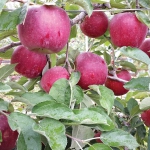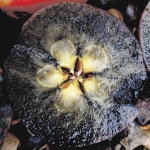Earlier Good Fruit Grower articles have described the taste and horticultural traits of the recently commercialized apple cultivar WA 38. In this article, we want to focus on the unique qualities of WA 38 fruit during maturation and storage.
WA 38 trees have been grown in four grower sites across Washington since 2008 for evaluation of horticultural traits. These sites were managed by the grower collaborator with input from the Breeding Program Advisory Committee.
All sites used evaporative cooling, but other horticultural practices varied widely, including pruning, training, fertilization, and calcium applications. In 2011 and 2012 we grafted WA 38 onto some discontinued selections in the trial plots, which are referred to as “grafts.”
A sufficient volume of fruit has been available since 2010 to enable storage evaluation using the 40-bin research controlled atmosphere rooms at the Stemilt Olds Station facility. All fruit was drenched with Stemilt commercial equipment before storage. Fruit has been stored in refrigerated regular air storage at 33°F for up to 6 months, and CA storage (1 percent carbon dioxide, 2 percent oxygen) for up to 10 months.
CA storage included Smartfresh (1-methylcyclopropene) treatments by Agrofresh either at Stemilt or at the Wenatchee Agrofresh location within one week of harvest. All fruit quality data after storage were taken after a 7-day shelf-life period at room temperature to simulate typical in-store display or consumer handling practices. Commercial packing line runs were performed on fruit from 4 month regular air and 6 month CA storage from three growing locations (Mattawa, Quincy, Prosser) in 2011 and 2012.

(Source: Washington Tree Fruit Research Commission)
The general protocol followed a generic Granny Smith run, which included an acid fruit wash and a Carnauba-based wax. WA 38 samples were run among commercial Granny Smith fruit and stored for up to three weeks in RA storage.
Here we present a summary of the post-harvest evaluation from the 2010 to 2013 seasons. The commercial size range of WA 38 is narrow; typically 80 percent or more fruit is distributed into four size classes (Figure 1). The bigger fruit size from younger orchards decreases as trees mature. Fruit shape is symmetrical, and the dark red color of fruit appears before fruit is fully mature at cooler sites or when evaporatively cooled (see Picture 1).
If fruit is grown in a warmer site, such as Mattawa, cooling is necessary to achieve a deeper red color. Cooler sites will produce fruit of a darker red color. WA 38 will be shipped meeting Washington State Department of Agriculture/USDA standards for grade and condition for partial red varieties.
At commercial maturity shown in Table 1, fruit firmness ranged from 17-20 pounds, soluble solids content (°Brix) is above 13°, and starch has cleared out of the core in a flowerlike fashion typical for WA 38. (See Picture 2)
We are currently using the generic Cornell starch chart (1-8) to rate fruit, but are in the process of developing a 1-6 scale preferred by most Washington growers. The range in starch clearing across fruit from one pick is narrow, and clearing within the typical harvest window is slow.
This leads us to believe that it will be possible to pick WA 38 in a single pick, and currently all fruit from the 2014 harvest was picked in this fashion. In addition, WA 38 has titratable acidity levels between 0.6-0.8 percent of malic acid at the time of harvest, higher than most other commercially grown cultivars in Washington.
Storage
In our experience, WA 38 can be stored with minimum losses throughout a yearlong storage period. Firmness is retained extremely well in CA storage (only 1-2 pounds loss in ten months). Also, sweetness becomes more intense as soluble solids content increases and acidity decreases with storage duration. (See Table 2). Given our current knowledge, we can confidently recommend regular air storage for four months (up to six months might be possible). CA storage with or without 1-MCP is possible for at least ten months.
Physiological disorders in storage such as bitterpit, superficial scald, soft scald, and internal browning have not been observed. The fruit is not sensitive to bruising, but bigger fruit from younger orchards can show stem punctures. In prolonged storage, fruit picked with more advanced maturity may become greasy unless it received 1-MCP treatment.
However, when running such fruit over a commercial packing line, the ability to wax these lots was not compromised and neither was appearance, taste or texture. Fruit have displayed no particular problems when subjected to general industry practices in commercial packing lines. Waxed WA 38 maintained its shine for at least seven days at room temperature.
WA 38 apples exhibit a balanced flavor with excellent crispness and juiciness which is maintained throughout storage. The fruit texture is similar to Honeycrisp, one of the cultivar’s parents. Samples of WA 38 will be available at numerous events throughout the 2014-15 meeting season. •
Look for WA 38 samples at the following upcoming events: Washington Tree Fruit Research Commission’s Apple Horticulture and Crop Protection Review, Pasco, on January 28-30; and the Northwest Pear Research Review on February 18-19.








Leave A Comment